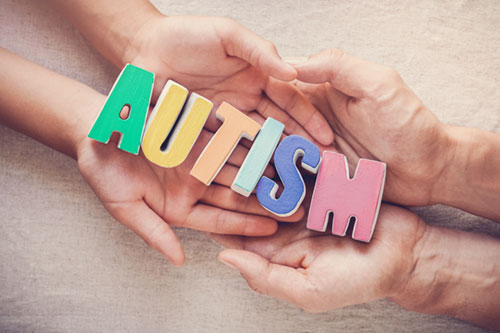Understanding the Invisible Spectrum & Embracing Neurodiversity

Every year, we observe April 2nd as World Autism Awareness Day – a day dedicated to amplifying voices from the spectrum, busting myths, and advocating for neurodivergent-affirming practices.
The DSM-5 (Diagnostic and Statistical Manual of Mental Disorders, Fifth Edition) defines autism spectrum disorder (ASD) as a neurodevelopmental disorder characterized by persistent deficits in social communication and social interaction manifested as deficits in social-emotional reciprocity, nonverbal communicative behaviors such as difficulty in eye contact, lack of facial expressions, lack of meaningful relationships and restricted, repetitive patterns of behavior, interests, or activities, that are manifested as stereotyped or repetitive motor movements, speech, or object use (e.g., echolalia, hand-flapping, lining up toys), inflexible adherence to routines, or ritualized patterns of behavior, fixated interests that are abnormal in intensity or focus, and hyper- or hypo-reactivity to sensory input or unusual interest in sensory aspects of the environment.
Autism is largely perceived as a childhood condition and often understood within the stereotypical textbook definitions. Autism doesn’t magically disappear when someone turns 18, nor does autism always fit into the stereotypical box of what people think it looks like as in the “Rain Man” or “Sheldon Cooper” archetypes. As a clinical psychologist, I’ve met many adults who have spent years feeling out of place, exhausted, low or struggling with relationships, being anxious at work, facing self-identity issues, issues in physical intimacy with a partner and many more issues that don’t fit the typical features only to later realize they are on the autism spectrum.
Autism isn’t just about kids who struggle to communicate, avoid eye contact, or engage in repetitive movements. Autism is a spectrum, and many individuals spend years — sometimes decades — without realizing they are autistic. Instead, they are misdiagnosed with depression, anxiety, personality disorders, or simply labelled as “too sensitive” or “too rigid” rather than the reality of high-functioning autism (HFA).
The Invisible Struggles of High-Functioning Autism
When people think of autism, they often picture a child who struggles with speech, avoids eye contact, engages in repetitive behaviours, or needs significant support for daily activities. What many don’t realize is that autism is a spectrum, and it doesn’t always look this way — especially in adults who have learned to mask their difficulties. Instead, HFA can manifest as:
- Feeling emotionally drained after social interactions
- Anxiety at work due to sensory sensitivities and routine disruptions
- Persistent low mood that doesn’t quite fit the mold of clinical depression
- Self-identity struggles and feeling “different” from peers
- Conflict in relationships due to communication differences
- Physical intimacy issues stemming from sensory sensitivities
Many adults with undiagnosed autism navigate life with overwhelming exhaustion, confusion about their struggles, and internalized shame — until they finally get the right diagnosis.
Research Underscores This Oversight
A study published in the British Journal of Psychiatry (Brugha et al., 2011) found that the prevalence of autism in adults of all ages in England was 11 per 1000, with many cases going unrecognized. Similarly, a study in JAMA Psychiatry (Xu et al., 2019) reported that the prevalence of autism spectrum disorders in adults was approximately 9.8 per 1000, with many individuals remaining undiagnosed. In the Indian context, the situation is equally concerning. A study highlighted the absence of standardized screening tools for adults with autism spectrum disorder (ASD) in India, emphasizing the urgent need for adult ASD screening policies (Mukherjee & Pradhan, 2020). Furthermore, a case series from a tertiary mental health care institute in India revealed that adults with ASD often face significant barriers to vocational rehabilitation. These barriers include a lack of awareness among healthcare professionals and the community, leading to delays in diagnosis and support (Kumar et al., 2021).
These findings highlight a critical gap in recognizing and diagnosing high-functioning autism in adults, both globally and within India. This gap often leads to misdiagnoses, leaving many individuals without the support they need. In my practice, I’ve encountered numerous cases where autism was overlooked due to these misconceptions. Let me introduce you to two such individuals.
When Autism Goes Under the Radar: The Musician and the Myth of Depression
One of my clients, a 32-year-old musician, came to therapy feeling stagnant in his career, struggling with focus, and experiencing persistent low mood. He had already been diagnosed with depression and had tried different treatments with little success. But something didn’t add up — his exhaustion wasn’t just emotional, it was sensory; his difficulty concentrating wasn’t just due to mood, but cognitive overload; and his “lack of motivation” stemmed from autistic burnout, not laziness. Through a comprehensive psychological assessment, we identified that he was on the autism spectrum. What he was experiencing wasn’t just burnout — it was autistic burnout. His struggles weren’t just about mood fluctuations, they stemmed from chronic sensory overload and the exhaustion of masking his neurodivergence in an industry that demanded constant networking and flexibility. The diagnosis was a revelation. He realized that his struggles weren’t personal failures but the result of sensory overload and executive functioning challenges. The diagnosis didn’t “fix” him, but it gave him the language to understand himself. He learned to honour his needs — adjusting his work routine, setting firm boundaries, and embracing sensory-friendly environments. With a neurodivergent-affirming approach, we worked on strategies to manage his sensory input, regulate his schedule in a way that worked for his brain, and implement self-compassion practices. Today, he’s not “cured” (because autism doesn’t need curing), but he’s thriving, adjusting his work in a way that suits his needs rather than forcing himself into neurotypical expectations.
Autism in Women: More Than Just ‘Being Too Rigid’
Another patient experience Mrs. Y that stands out is a 28-year-old married woman who initially came in with complaints of relationship conflicts and physical intimacy difficulties. She had been labelled as having obsessive-compulsive personality disorder (OCPD) due to her rigidity and perfectionism. However, in therapy, there were red flags — her perfectionism wasn’t about control, it was about predictability. Her conflicts weren’t about stubbornness, they were about struggling to see things from another’s perspective. Her difficulties with physical intimacy weren’t about emotional detachment but stemmed from hypersensitivity to touch that made certain types of touch unbearable, and sensory sensitivities with bodily fluids. A detailed psychometric evaluation revealed high-functioning autism. Her difficulties in communication weren’t because she “lacked empathy”, but because she processed social cues differently. With a neurodivergent-affirming approach, Mrs Y and her partner learned to navigate their differences with understanding, not judgment. They adapted their communication styles, made informed decisions about their relationship, and most importantly, stopped trying to force into a neurotypical mold.
Embracing Neurodiversity: Moving Beyond the Medical Model
Stories like Mr X and Mrs Y are far too common. Too often, autism is seen through a medical lens — as something to be diagnosed and “treated” rather than understood and supported. High-functioning autism, in particular, often goes unnoticed because it doesn’t fit the traditional narrative. But just because someone can hold a job or maintain relationships doesn’t mean they aren’t struggling. They don’t necessarily struggle with verbal communication, they may maintain eye contact, and they may not display overtly repetitive behaviours. But that doesn’t mean they don’t face real challenges. Being autistic isn’t just about difficulties; it’s about differences. The problem isn’t the individual — it’s a world that wasn’t designed with neurodiversity in mind.
Instead of trying to “fix” autistic individuals to fit neurotypical expectations, we need to move towards the social model of disability, where we focus on making environments, workplaces, and relationships more accommodating and seek pharmacological interventions as required to handle emotional dysregulation challenging daily living or other comorbid conditions.
This World Autism Awareness Day, let’s move beyond awareness and into acceptance. Let’s recognize that autism isn’t just a childhood condition, autism doesn’t have a deadline and that high-functioning autism comes with its own set of challenges. True support lies in affirming neurodivergent identities rather than forcing them to conform. Because the goal isn’t to make autistic people less autistic — it’s to create a world where they don’t have to hide who they are.
If you or someone you know resonates with these experiences, seeking a professional assessment can be life-changing. You’re not alone, and you’re not broken. You’re just wired differently – and that’s okay.

Ms Tinu Thamby
Clinical Psychologist
Kauvery Hospital, Chennai

